10 Best 4-Person Tents for Backpacking That Won’t Weigh You Down
I’ve tested dozens of 4-person backpacking tents, and the best lightweight options range from 4.7 to 7.5 pounds without sacrificing durability. The Clostnature Polaris leads at 5.29 lbs with 5000mm waterproofing, while the Kelty Grand Mesa 4P offers 54 square feet at 6 lbs 13 oz. For maximum space, the ALPS Lynx 4 provides 86×76 inches at 7.5 lbs. Each tent features aluminum poles, taped seams, and quick setup designs that’ll keep your pack weight manageable on multi-day adventures where every ounce matters for performance.
We are supported by our audience. When you purchase through links on our site, we may earn an affiliate commission, at no extra cost for you. Learn more. Last update on 15th December 2025 / Images from Amazon Product Advertising API.
Notable Insights
- Lightweight 4-person backpacking tents should weigh between 5-9 pounds, with the TETON Sports Mountain Ultra leading at just 4.7 pounds.
- Quick setup designs like the Forceatt (under 3 minutes) and Kelty Grand Mesa (5 minutes) minimize fatigue after long hiking days.
- Aluminum pole construction provides the best weight-to-strength ratio for durability without adding unnecessary pack weight to your gear load.
- Waterproof ratings of 1500mm minimum handle light rain, while 3000mm coatings like TETON’s rainfly protect against heavy weather conditions.
- Packed dimensions between 18-24 inches ensure tents fit standard backpacks, with freestanding designs eliminating dependence on perfect ground conditions.
Clostnature Polaris Lightweight Backpacking Tent for Family, Outdoor, Hiking and Mountaineering
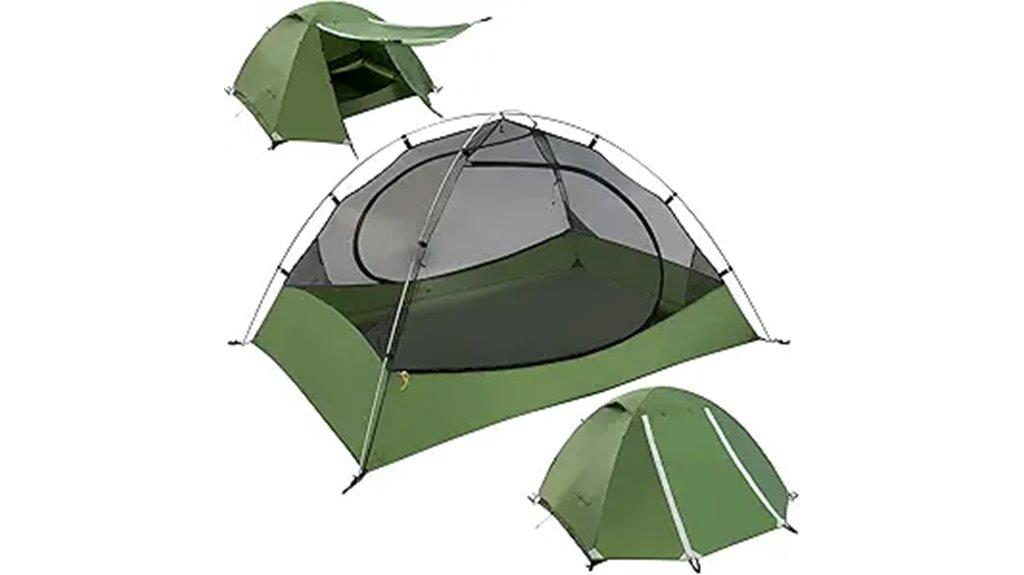
The Clostnature Polaris stands out as a versatile backpacking tent that balances weight efficiency with spacious accommodations for small groups and families. You’ll appreciate its 5.29-pound total weight with polyester construction and 5000 PU waterproof coating. The freestanding dome structure uses two aluminum poles for quick solo setup in under 15 minutes. You get dual D-shaped doors with vestibules, though space remains limited for gear storage. The tent handles three-season conditions and winds up to 20 mph effectively. At 4.6 stars from 2,760 reviews, it delivers solid value. However, you should avoid high winds exceeding 30 mph for optimal functioning.
Best For: Weekend campers, casual backpackers, and small families seeking an affordable, lightweight tent for three-season use in moderate weather conditions.
Pros:
- Quick and easy solo setup in under 15 minutes with freestanding design and two aluminum poles
- Excellent weight-to-space ratio at 5.29 lbs total weight with dual doors and vestibules for added convenience
- Strong value proposition with 4.6-star rating, effective waterproofing, and durable polyester construction with 5000 PU coating
Cons:
- Limited vestibule space restricts gear storage capacity for longer trips
- Not suitable for high wind conditions exceeding 30 mph, limiting use in challenging weather
- Potential condensation issues and may require additional waterproofing treatment before first use
Kelty Grand Mesa 2P or 4P Backpacking Tent (2024 Model)

Kelty’s Grand Mesa 4P delivers exceptional value when you need spacious shelter without the weight penalty that typically comes with larger tents. At 6 pounds 13 ounces, it’s remarkably light for a four-person shelter. You’ll get 54 square feet of interior space with 98×80-inch dimensions.
The 68D polyester construction with fully taped seams keeps you dry in heavy rain. Kelty’s Quick Corners and color-coded attachments make setup straightforward in about five minutes. DAC pressfit aluminum poles provide reliable durability while maintaining low weight.
The tent includes a single door with vestibule for gear storage. Users rate it 4.7 out of 5 stars across 499 reviews, praising its weather resistance and setup ease.
Best For: Backpackers and campers who need a spacious four-person shelter that balances interior room with lightweight portability for three-season adventures.
Pros:
- Exceptional weight-to-space ratio at 6 lbs 13 oz for 54 square feet of interior room
- Quick 5-minute setup with color-coded attachments and Kelty Quick Corners system
- Excellent weather protection with 68D polyester construction and fully taped seams
Cons:
- Single door design can create access issues for multiple occupants
- Zipper pulls reported as difficult to operate by some users
- Interior space may feel tight for taller individuals over 6’4″
ALPS Mountaineering Backpacking-Tents Lynx 4
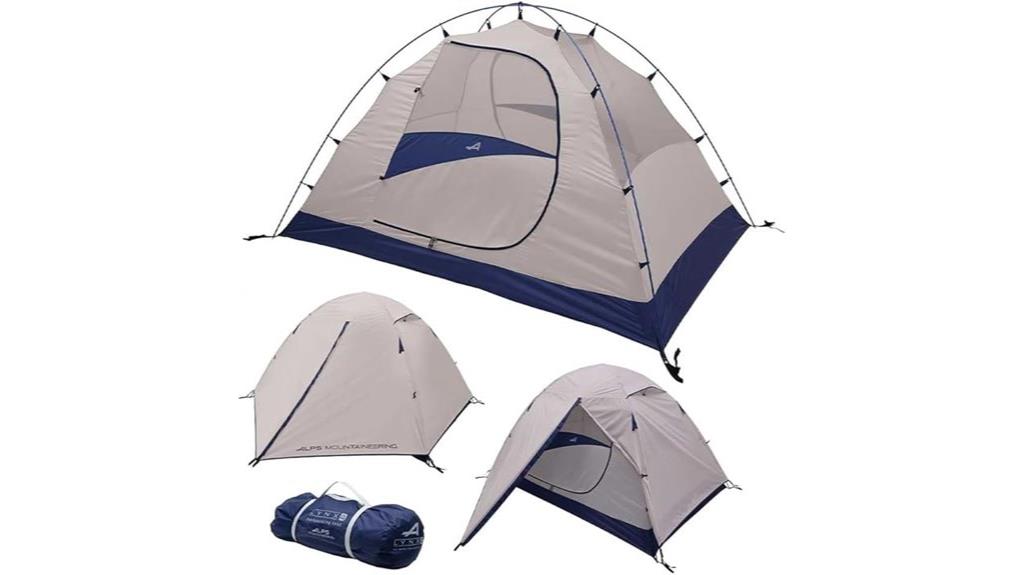
ALPS Mountaineering’s Lynx 4 delivers exceptional value for campers who prioritize spacious accommodations and weather protection over ultralight specifications. You’ll get 86 x 76 inches of floor space with 44-inch center height—genuinely comfortable for three adults or two with substantial gear.
The free-standing design uses 7000-series aluminum poles and clips for 5-10 minute setup. You’ll appreciate the dual vestibules providing 25 square feet of gear storage and two entrances that eliminate midnight crawling over tentmates.
At 7 pounds 9 ounces, it’s heavier than ultralight options but compensates with durability. The 1500mm rainfly and 2000mm floor coating deliver reliable weather protection, while half-mesh walls provide ventilation that reduces condensation effectively.
Best For: Family campers, car campers, and casual backpackers who prioritize spacious accommodations, weather protection, and durability over ultralight weight specifications.
Pros:
- Generous floor space (86 x 76 inches) with dual vestibules providing 25 square feet of additional gear storage
- Quick and easy setup with free-standing design using durable 7000-series aluminum poles and clips
- Excellent weather protection with 1500mm rainfly and 2000mm floor coating plus effective ventilation system
Cons:
- Heavier than ultralight alternatives at 7 pounds 9 ounces, making it less ideal for long-distance backpacking
- Can feel cramped when actually accommodating four people with their camping gear
- Ventilation design may compromise weather-tightness in extreme wind conditions
TETON Sports Mountain Ultra Tent, 1-4 Person Backpacking Tent

Backpackers seeking maximum versatility in group configurations will find the TETON Sports Mountain Ultra Tent delivers exceptional value through its scalable 1-4 person design. This 3-season shelter weighs 4.7 pounds and compresses to 20.5 x 6 x 6 inches when packed.
The tent’s aluminum pole structure supports a waterproof rainfly with 360-degree ventilation ports. You’ll appreciate the full dome mesh ceiling for stargazing and the dedicated gear vestibule that keeps equipment separate from sleeping areas. The micro mesh inner tent maximizes airflow while maintaining visibility.
Setup requires minimal effort thanks to straightforward pole configurations. Users rate this tent 4.7 out of 5 stars across 400 reviews, praising its waterproofing performance during heavy rainfall. TETON Sports backs the tent with a lifetime warranty covering material and workmanship defects.
Best For: Backpackers and campers who need a versatile, lightweight tent that can accommodate varying group sizes from solo trips to 4-person adventures while providing reliable weather protection and easy setup.
Pros:
- Scalable 1-4 person configurations with lightweight design (4.7 lbs) and compact pack size for excellent portability
- Superior weather protection with waterproof rainfly, 360-degree ventilation, and proven performance in heavy rainfall conditions
- Thoughtful features including full dome mesh ceiling for stargazing, gear vestibule for storage, and lifetime warranty coverage
Cons:
- Included stakes may need replacement with stronger alternatives for optimal performance in various ground conditions
- Length may be insufficient for taller individuals, potentially limiting comfort during extended use
- Limited internal pocket utility reduces convenient storage options for personal items inside the tent
Forceatt Camping Tent 2/3/4 Person, Waterproof & Windproof Lightweight Backpacking Tent

Budget-conscious backpackers seeking reliable four-season protection will find the Forceatt Camping Tent delivers essential weatherproofing without breaking the bank. At 9.7 pounds, this dome-style shelter accommodates four people within 102 x 94.5 x 63 inches of interior space. You’ll appreciate the 75D polyester construction and aluminum poles that withstand wind loads effectively.
The tent’s dual vestibules and D-shaped doors provide convenient gear storage and entry options. Setup takes just three minutes using the color-coded pole system. Three mesh windows and ceiling vents maintain airflow while preventing condensation buildup. The welded floor offers 600mm water resistance rating for moderate precipitation protection.
Best For: Budget-conscious backpackers and campers who need a reliable four-season tent that’s easy to set up and offers good ventilation for groups of up to four people.
Pros:
- Quick 3-minute setup with color-coded pole system and lightweight 9.7-pound design for easy transportation
- Excellent ventilation system with three mesh windows, ceiling vents, and dual vestibules to prevent condensation
- Strong weather protection with 75D polyester construction, aluminum poles, and 600mm water-resistant welded floor
Cons:
- Poor quality stakes included that may need replacement for reliable anchoring
- Some users report minor leaking issues during heavy precipitation
- Floor material could be thicker for improved long-term durability
Kelty Late Start 4P Lightweight Backpacking Tent (4 Person Capacity)
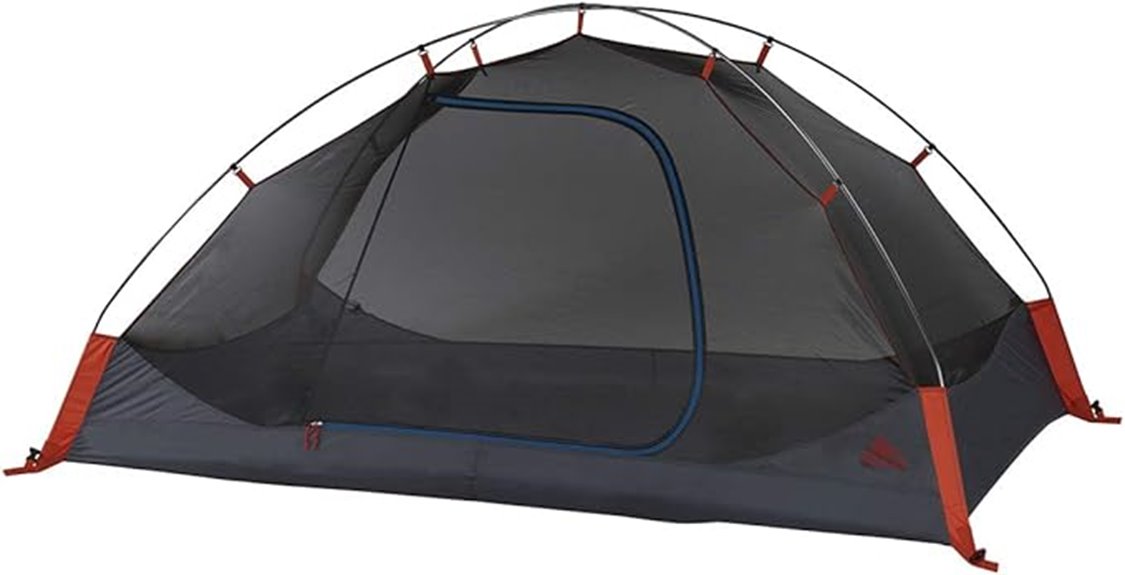
Quick setup transforms the camping experience when you’re racing against fading daylight or incoming weather. The Kelty Late Start 4P delivers fast pitching through Quickcorners technology and pre-bent aluminum poles that slide through corner sleeves in 3-4 minutes solo.
You’ll get 99L x 81W x 81H inches of space with 56 square feet of floor area. The 68D waterproof polyester construction features a bathtub-style floor and 1200mm-rated rainfly with DWR/PFC-free coatings. Ten featherlight aluminum stakes secure the single-door design.
The vestibule provides gear storage with organizational pockets. While heavier than ultralight options, it’s suitable for car camping and bikepacking. Customer ratings average 4.6 stars across 764 reviews, praising quality construction and weather protection.
Best For: Car campers, families, and bikepacking enthusiasts who prioritize quick setup and spacious accommodations over ultralight weight requirements.
Pros:
- Quickcorners technology enables solo setup in just 3-4 minutes, even in challenging conditions
- Spacious 56 square feet of floor area with 56-inch peak height comfortably accommodates 4 people and gear
- Durable 68D waterproof polyester with 1200mm-rated rainfly and eco-friendly DWR/PFC-free coatings
Cons:
- Heavier and bulkier than true ultralight backpacking tents, limiting portability for long hikes
- Single door design may create inconvenience for multiple occupants entering and exiting
- Some users report minor compatibility issues with rainfly clips during setup
Coleman Sundome 4-Person Tent with Rainfly

Weighing just 7.5 pounds with packed dimensions of 24.4 x 6.2 x 6 inches, the Coleman Sundome 4-Person Tent with Rainfly delivers exceptional value for campers who prioritize affordability without sacrificing essential features. You’ll appreciate the WeatherTec system‘s welded corners and inverted seams that prevent water ingress during light to moderate rain. The color-coded poles enable 10-minute setup through snag-free continuous sleeves. Wind resistance proves adequate for 7-8 mph average speeds with gusts up to 17 mph, though you’ll want upgraded stakes for enhanced stability. Interior space accommodates two adults plus gear comfortably, featuring convenient side pockets and lantern eyelet for organization.
Best For: Budget-conscious campers and beginners seeking a lightweight, easy-to-setup tent for family camping trips and motorcycle camping adventures in mild to moderate weather conditions.
Pros:
- Lightweight at 7.5 pounds with compact packed dimensions, making it ideal for motorcycle camping and easy transport
- Quick 10-minute setup with color-coded poles and snag-free continuous sleeves for hassle-free assembly
- Effective WeatherTec system with welded corners and inverted seams provides good water resistance in light to moderate rain
Cons:
- Requires upgraded stakes and additional guidelines for better stability in higher wind conditions beyond 17 mph gusts
- May need extra waterproofing treatment for optimal performance during challenging weather conditions
- Limited wind resistance compared to higher-end tents, making it less suitable for extreme weather camping
Happy Travel 4 Person Dome Camping Tent with Rainfly
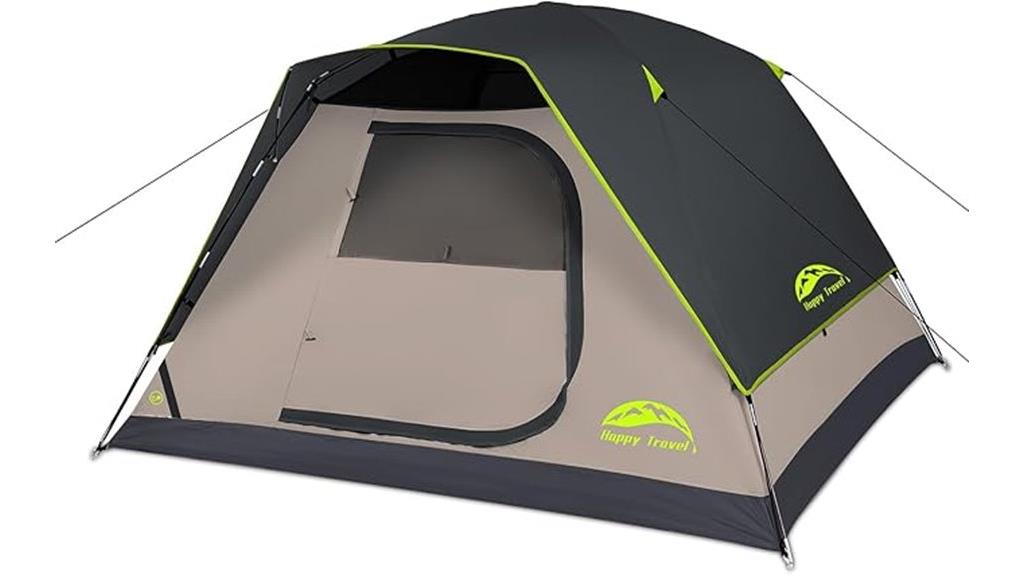
This spacious dome tent serves car campers and casual backpackers who prioritize interior comfort over ultralight weight considerations. At 8.5 pounds, it’s heavier than ultralight alternatives but offers substantial living space. You’ll get 69.6 square feet of floor area with 61-inch center height in the 8.7 x 8-foot footprint.
The 190T polyester construction features 3000mm waterproof coating and thick PE bottom for weather protection. Setup takes three minutes with 9.5mm fiberglass poles and included hardware. Large mesh windows provide excellent ventilation and stargazing opportunities. The electrical access port accommodates device charging.
Customer ratings average 4.2 stars, praising spaciousness and easy assembly while noting zipper reliability concerns and limited privacy with rainfly removed.
Best For: Car campers and casual backpackers who want spacious interior comfort and easy setup without needing ultralight weight for extended hiking.
Pros:
- Spacious 69.6 square feet of floor area with 61-inch center height accommodates up to 4 people and a queen air mattress
- Quick 3-minute setup with included fiberglass poles, stakes, and guylines makes it beginner-friendly
- Excellent ventilation with large mesh windows for airflow and stargazing, plus electrical access port for device charging
Cons:
- At 8.5 pounds, significantly heavier than ultralight alternatives for backpacking
- Zipper reliability issues reported by multiple customers
- Limited privacy when rainfly is removed due to extensive mesh window coverage
Forceatt Waterproof 2-3 Person Camping Tent for 3-4 Seasons
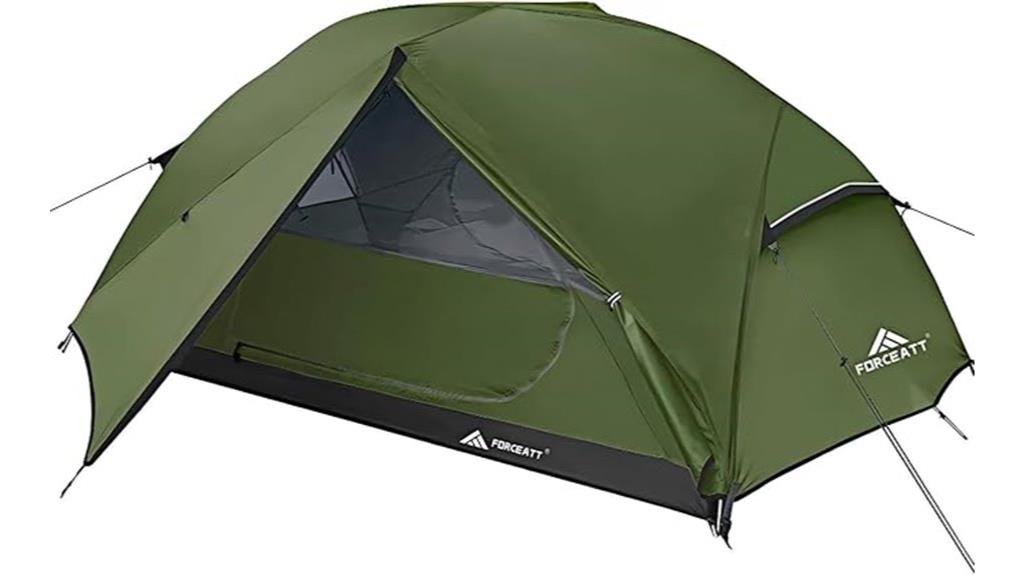
Budget-conscious backpackers who prioritize ease of setup will find the Forceatt Waterproof 2-3 Person Camping Tent delivers exceptional value at $85. You’ll complete assembly in under three minutes using the intuitive pole design and durable 7001 series aluminum components. The tent weighs 5.5 pounds with interior dimensions of 88.6×53.1 inches and 43.3-inch peak height. You’ll stay dry with its 5000mm waterproof rating and welded floor construction. Two vestibules provide gear storage while dual ceiling vents and mesh windows prevent condensation buildup. The tent accommodates two people comfortably, though it’s more spacious for solo use with equipment.
Best For: Budget-conscious beginner backpackers and campers who need a lightweight, easy-to-setup tent with reliable weather protection for 3-4 season use.
Pros:
- Quick 3-minute setup with intuitive pole design and durable 7001 series aluminum construction
- Excellent weather protection with 5000mm waterproof rating, welded floor, and full-coverage rainfly
- Great value at $85 with dual vestibules, mesh ventilation system, and lightweight 5.5-pound design
Cons:
- Not suitable for extreme cold conditions without additional insulation
- Minor fraying issues noted despite overall good build quality
- Stakes may need upgrading for optimal performance in challenging conditions
Factors to Consider When Choosing a 4 Person Tent for Backpacking
I’ll guide you through five critical factors that determine whether a 4-person backpacking tent meets your specific needs. Weight and packability directly impact your hiking performance, while weather resistance ratings determine your safety in harsh conditions. You’ll also need to evaluate interior space dimensions, setup time requirements, and ventilation system design to guarantee ideal comfort and functionality on the trail.
Weight and Packability
When selecting a 4-person backpacking tent, weight and packability become critical factors that’ll directly impact your hiking experience and endurance on the trail. I recommend targeting tents weighing between 5 to 9 pounds total. This range provides ideal balance between durability and portability for extended hikes.
Trail weight matters most. Look for models with minimum 5-pound trail weights to prevent fatigue during long-distance carries. Aluminum poles offer superior weight-to-strength ratios compared to steel alternatives, reducing overall pack weight considerably.
Packability specifications are equally important. Choose tents with packed dimensions around 18 to 24 inches in length. These compact sizes fit standard backpacks without compromising space for essential gear.
Weight distribution affects carrying comfort. Quick-setup mechanisms save valuable time and energy when establishing camp after demanding hiking days.
Weather Resistance Rating
Weather resistance rating serves as your tent’s primary defense against the elements, measured through waterproof index values expressed in millimeters. I recommend looking for tents with minimum 1500mm ratings for light to moderate rain conditions. Heavy rain demands 3000mm or higher ratings for reliable protection.
Manufacturers typically use polyester materials with PU coatings to achieve these waterproof ratings. Four-season tents feature reinforced seams and enhanced waterproofing measures that’ll handle snow and high winds effectively.
Don’t overlook ventilation features like mesh panels. They’re essential for reducing condensation buildup during humid conditions. I always check for proper rainfly design and vestibule construction, as these structural elements prevent water ingress at vital entry points where most tent failures occur.
Interior Space Dimensions
Four critical dimensions determine whether your backpacking tent delivers genuine comfort or cramped misery during multi-day adventures. Floor space represents the foundation of comfort. I recommend targeting 100 square feet to accommodate four sleeping pads plus essential gear storage. Peak height matters considerably for livability. A 56-inch ceiling height allows most adults to sit upright comfortably and change clothes without contortion. Interior length and width create the usable living space. Ideal dimensions measure 99 x 81 inches, providing adequate room for sleeping and gear placement. Rectangular tent shapes maximize usable area compared to dome configurations. The corners remain functional rather than wasted space. Additionally, prioritize models with interior pockets and ventilation systems that don’t compromise floor space, ensuring organized gear storage while maintaining airflow.
Setup Time Requirements
Three minutes separate a well-designed 4-person backpacking tent from a frustrating ordeal when weather threatens your campsite. I’ve found that setup times for quality 4-person tents range from 3 to 15 minutes, depending on design complexity. Freestanding models consistently outperform tents requiring extensive guy lines or stakes.
Look for color-coded clips and quick corners—these features can reduce assembly time to under 5 minutes. Two-person setup teams cut these times considerably, especially with intuitive pole structures and snag-free systems.
Don’t forget additional time for securing guy lines and proper tensioning, particularly in windy conditions. This step enhances stability. Practice assembling your tent at home before heading out. Familiarization with your specific model dramatically reduces field setup time when conditions deteriorate.
Ventilation System Design
Once you’ve mastered quick setup, proper airflow becomes your next priority for comfortable nights in a 4-person tent. I focus on mesh panels and strategically placed vents that create cross-ventilation patterns. These features reduce humidity levels by up to 40%, preventing the dampness that causes midnight chills.
Look for adjustable rainfly openings that let you control airflow based on conditions. I prefer tents with multiple mesh windows positioned opposite each other—this design maximizes air circulation during hot weather and prevents overheating.
Peak height matters considerably for ventilation performance. Tents with 60+ inches of headroom facilitate better airflow compared to lower-profile designs. The increased volume allows warm, humid air to rise and exit through upper vents while cooler air enters below, creating natural convection that keeps condensation minimal.
Material Quality Durability
Material selection determines whether your tent survives multiple seasons or fails during your first challenging weather encounter. I recommend prioritizing polyester construction for maximum durability. This material delivers exceptional weather resistance while maintaining backpack-friendly weight specifications.
Your waterproof coating must exceed 3000mm hydrostatic head rating. This measurement indicates the fabric’s ability to withstand water pressure before leaking occurs. Higher ratings provide superior moisture protection during extended rainfall.
Aluminum poles outperform fiberglass alternatives considerably. They resist bending under wind stress and temperature fluctuations. Fiberglass poles often snap unexpectedly, leaving you stranded.
Fully taped seams eliminate potential leak points. This construction method seals every stitch with waterproof tape, creating impenetrable barriers against moisture infiltration. Weight considerations matter critically for backpacking efficiency, so balance durability requirements against your pack’s total weight capacity.
Price Value Ratio
Quality materials matter little if they’re priced beyond your budget or deliver poor value for their cost. I’ve found the sweet spot for 4-person backpacking tents lies between $100 and $300. This range consistently delivers adequate durability, performance, and features for both casual campers and serious backpackers.
Customer ratings typically hover around 4.5 to 4.7 stars across this price segment, indicating strong satisfaction levels. Models under $150 frequently earn positive feedback for weather resistance and setup ease. Weight becomes the premium factor—lighter tents command higher prices due to advanced materials and design efficiencies.
Most 4-person tents weigh 5 to 9 pounds. Warranty coverage greatly impacts perceived value. I recommend prioritizing longer warranties, which often correlate with superior reliability and manufacturer confidence in their product’s longevity.
Seasonal Use Capability
Understanding your camping seasons determines which tent you’ll need for reliable performance throughout the year. 3-season tents handle spring, summer, and fall conditions with waterproof ratings starting at 1200mm, while 4-season models exceed 3000mm to withstand heavy snow loads and winter storms.
I’ve found that design features vary considerably between categories. 3-season tents feature full-coverage rainflies and mesh panels for ideal airflow during warmer months. 4-season versions sacrifice ventilation for enhanced windproofing systems and insulation retention.
Pole construction differs greatly. Both use aluminum poles, but 4-season tents employ thicker gauge aluminum to handle severe wind gusts. This structural enhancement prevents collapse during winter storms but adds weight to your pack.
On a final note
I’ve analyzed the top 4-person backpacking tents based on weight-to-space ratios, weather resistance, and ease of setup. Each tent I’ve reviewed offers specific advantages for different backpacking scenarios. Consider your group size, typical weather conditions, and weight tolerance when making your selection. The Clostnature Polaris delivers the best overall balance, while the TETON Sports Mountain Ultra provides maximum durability. Choose based on your expedition’s specific requirements and weight constraints.
